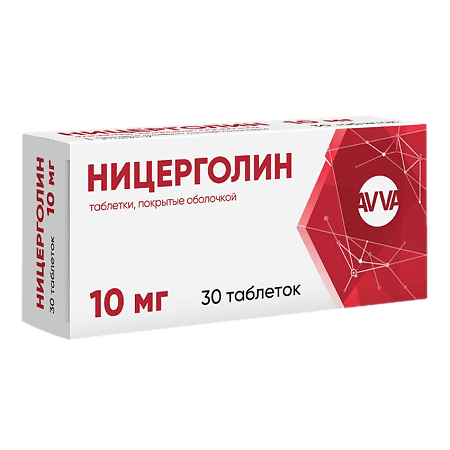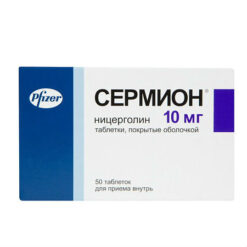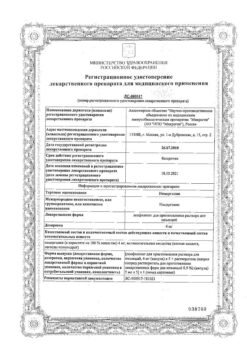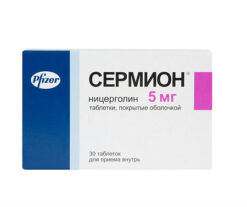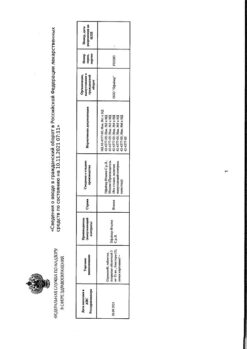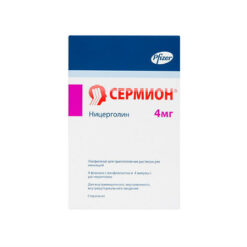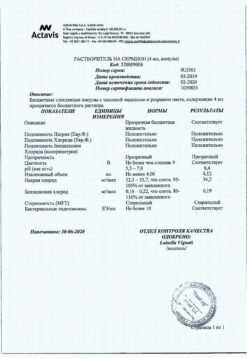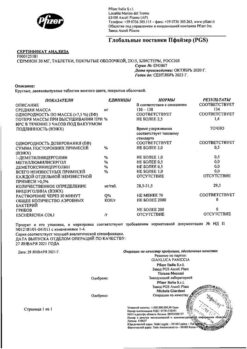No products in the cart.
Nitsergoline, 10 mg 30 pcs
€17.50 €14.58
Description
Pharmacotherapeutic group: alpha-adrenoblocker.
ATX code: CO4AE02
Pharmacological properties:
Pharmacodynamics:
Nicergoline is an ergoline derivative, improves metabolic and hemodynamic processes in the brain, reduces platelet aggregation and improves hemorheological blood parameters, increases blood flow rate in the upper and lower extremities. Nitsergoline exhibits alpha-1-adrenoblocking effect that leads to improved blood flow and has a direct effect on cerebral neurotransmitter systems – noradrenergic, dopaminergic and acetylcholinergic. Against the background of using the drug the activity of noradrenergic, dopaminergic and acetylcholinergic cerebral systems increases, which promotes optimization of cognitive processes.
As a result of long-term therapy with nicergolin there is a steady improvement in cognitive function and reduction of behavioral disorders associated with dementia.
Pharmacokinetics:
After oral administration, nicergoline is quickly and almost completely absorbed. The main products of metabolism of nicergoline are 1,6-dimethyl-8β-hydroxymethyl-10α-methoxyergoline (MMDL, hydrolysis product) and 6-methyl-8β-hydroxymethyl-10α-methoxyergoline (MDL, dimethylation product under the action of CYP2D6 isoenzyme). The ratio of the area under the concentration-time curve (AUC) for MMDL and MDL when nicergoline is taken orally indicates marked metabolism “at first passage” through the liver. After oral administration of 30 mg of nicergoline, maximum concentrations of MMDL
(21±14 ng/mL) and MDL (41±14 ng/mL) were reached after approximately 1 and 4 hours, respectively, and then MDL concentrations declined with a half-life of 13 to 20 hours. Studies confirm the absence of accumulation of other metabolites (including MMDL) in the blood. Food intake or dosage form has no significant effect on the degree and rate of absorption of nicergoline.
Nicergoline actively (>90%) binds to plasma proteins, with a greater degree of affinity for α1-acid glycoprotein than for serum albumin. It has been shown that nicergoline and its metabolites can be distributed in blood cells. The pharmacokinetics of nicergoline at doses up to 60 mg are linear and do not vary with the age of the patient.
Nicergoline is excreted in the form of metabolites, mainly by the kidneys (about 80% of the total dose), and in small amounts (10-20%) – through the intestine. In patients with severe renal insufficiency, there is a significant decrease in the degree of excretion of metabolites with urine compared to patients with normal renal function.
Indications
Indications
Symptomatic therapy of cognitive disorders, including dementia in chronic cerebrovascular and organic brain lesions accompanied by decreased memory, concentration, thinking, activity, increased fatigability, emotional disorders.
Note: Before starting therapy with nicergolin it is necessary to make sure that these symptoms are not a manifestation of another disease (such as internal diseases, psychiatric or neurological diseases) and do not require specific therapy.
Active ingredient
Active ingredient
Composition
Composition
Composition per tablet:
Active substance:
Nicergoline (in terms of 100% substance) – 10.0 mg.
Excipients: potato starch – 26.9 mg, colloidal silica – 2.0 mg, magnesium stearate – 1.1 mg, lactose monohydrate – until making an uncoated tablet weighing 110.0 mg.
Shell excipients up to 180.0 mg coated tablet: sucrose – 48.1159 mg, magnesium carbonate (light) – 19.8800 mg, povidone K-17 – 1.0000 mg, beeswax – 0.3880 mg, titanium dioxide – 0.3036 mg, talc – 0.2990 mg, colloidal silicon dioxide – 0.0135 mg.
How to take, the dosage
How to take, the dosage
Interaction
Interaction
Special Instructions
Special Instructions
In clinical studies, it has been shown that single or repeated use of nicergolin can decrease systolic and to a greater extent diastolic blood pressure in patients with normal and elevated blood pressure. These results may vary because other studies have shown no change in blood pressure values.
The drug works gradually, so it should be taken over a long period of time, with the physician periodically (at least every 6 months) evaluating the effect of treatment and whether it should be continued.
The development of fibrosis (e.g., pulmonary, cardiac, heart valve, and retroperitoneal) has been associated with the use of ergot alkaloids with antagonistic activity to 5HT2β serotonin receptors.
Symptoms of ergotism (including nausea, vomiting, diarrhea, abdominal pain, and peripheral vasoconstriction) have been reported with some ergot alkaloids and their derivatives.
Clinicians should be aware of the possible symptoms of ergot overdose before prescribing this class of drugs.
Impact on ability to drive and operate machinery:
While nicergoline improves reaction and concentration, its effects on the ability to drive and operate complex machinery have not been specifically studied. In any case, caution should be exercised given the nature of the underlying disease, especially given that dizziness or drowsiness may develop in some cases.
Synopsis
Synopsis
Contraindications
Contraindications
Recent myocardial infarction, acute bleeding, marked bradycardia, orthostatic dysregulation, hypersensitivity to nicergoline, other ergotamine derivatives or other drug components, sucrose/isomaltase deficiency, fructose intolerance, glucose-galactose malabsorption, age under 18, pregnancy, breastfeeding.
With caution:
Hyperuricemia or gout in the history and/or in combination with drugs that impair uric acid metabolism or excretion.
Concurrent use with sympathomimetic agonists (alpha- and beta-).
Side effects
Side effects
System-organ class
Very frequent â¥1/10
Frequent â¥1/100 to < 1/10
Infrequent â¥1/1,000 to < 1/100
Rare â¥1/10000
to
< 1/1,000
Very
rare < 1/10,000
Frequency unknown (impossible to estimate based on available data)*
Mental disorders
psychomotor
agitation,
confusion
consciousness,
insomnia
Nervous system disorders
/p>
drowsiness, dizziness, headache
feeling hot
Vascular disorders
Decrease in blood pressure (BP), mostly after parenteral administration, “rushes” of blood to the skin of the face
.
Disorders from
the gastrointestinal side
/p>
a discomfort feeling in the stomach
/p>
diarrhea, constipation, nausea, dyspeptic phenomena
Skin and subcutaneous disorders
/td>
cutaneous itching
/p>
skin rashes
/td>
laboratory
and instrumental findings
increase in uric acid concentration in the blood (this effect is independent of the dose and duration of therapy)
Immune system disorders
/p>
allergic reactions in the form of skin itching and rash/p>
.p> * Adverse reactions identified during post-registration use of nicergoline.
An association has been noted with the development of fibrosis (e.g., pulmonary, cardiac, heart valve, and retroperitoneal) when using ergot alkaloids that have antagonistic activity to 5HT2β serotonin receptors.
Overdose
Overdose
Pregnancy use
Pregnancy use
Similarities
Similarities
Additional information
| Shelf life | 2 years. Do not use later than indicated on the package. |
|---|---|
| Conditions of storage | Store in a light-protected place at a temperature not exceeding 25 °С. Keep out of reach of children. |
| Manufacturer | Avva Rus, Russia |
| Medication form | pills |
| Brand | Avva Rus |
Other forms…
Related products
Buy Nitsergoline, 10 mg 30 pcs with delivery to USA, UK, Europe and over 120 other countries.

